Similar presentations:
Productive system and Process Approach. Operations Management in Corporate Profitability and Competitiveness
1. 1.2 Productive system and Process Approach Operations Management in Corporate Profitability and Competitiveness
JAP1
2.
LEARNING GOALS after these lessons you will be ableto
1. describe operations in terms of inputs, processes, outputs,
information flows, suppliers and customers,
2. explain the meaning of nested processes,
3. identify the set of decisions that operations managers make
4. describe operations as a function alongside finance, accounting,
marketing and human resources,
5. explain how operations management is fundamental to both
manufacturers and service organizations,
6. describe the differences and similarities between manufacturing
and service organizations,
JAP
2
3.
LEARNING GOALS after these lessons you will be able to7. discuss trends in operations management, including service
sector growth; productivity changes; global competition; and
competition based on quality, time and technology,
8. discuss the need for operations management to develop and
maintain both intraorganizational and interorganizational
relationships and
9. give examples of how operations can be used as a competitive
weapon.
JAP
3
4.
What is a Productive system(Buffa), what is a Process
(Krajewski& Ritzman)?
Examples of
• Productive systems, Processes
• Products versus services
• Services as part of product
• Products as part of service
JAP
JAP
4
5.
EXAMPLES OF PRODUCTIVE SYSTEMS:Electronics assembly
Airplane manufacturing
Steel production
Automobile assembly
Oil refining
Fast food outlet
Hospital
Air transportation
Car seller
EDP -support
JAP
5
6.
Why must a system has to beproductive?
JAP
6
7.
Company’scompetitiveness
increasess
To fullfill the
expectations
of different
stakeholders
Why must a system have to
be productive?
Money for
Improving
Quality of:
Products
Services,
Processes
Work Safety,
Environment
PROFITABILITY
and continuity
JAP
Money to pay:
Salaries,
Divideds,
Interests,
Investments,
Taxes,
Provide jobs,
7
8.
What is a Productive system ?(Buffa means here production system)
• We define productive systems as the means
by which we transform resource inputs to
create useful goods and cervices as outputs.
• Productive systems resource inputs (and
examples of output-input ratio)
– Labor (man hour – mobile phone / man hour)
– Materials (kg, m, … - phone (pc) / plastic (kg))
– Investments: machines, facilities, information,
storage, know how, education
– Energy (Joule, KWh - Finished Products / KWh
– Overall
JAP
Buffa et al.
8
9.
PRODUCTIVITY (is the value of outputs(goods, services) produced and divided by the
values of input resources) IS THE RATIO OF
OUTPUT TO INPUT, OR
PRODUCTIVITY =
OUTPUT
INPUT
INPUT
PRODUCTION
PROCESS
JAP
Not concerned
by money (but
sometimes yes)
OUTPUT
9
10.
example 1 / productivityCalculate the productivity for the following
operations:
a) Three employees process 600 insurance
policies in a week. They work 8 hours per
day, 5 days a week.
b) A team of workers make 400 units of a
product, which is valued by its standard cost
of 10 € each (before profit). The accounting
department report that for this job the actual
costs are 400 € for labor, 1000 € for material
and 300 € overhead.
JAP
11.
Labor productivity = Processes policies / Employeehours
600 policies / week
policies
=5
3 employees * 40 hours /employee
hour
Multifactor productivity = Quantity of standard cost /
(labor cost + material cost + overhead cost)
400 units * 10 € / unit
4000 €
=
(400 + 1000 + 300 ) €
= 2,35
1700 €
JAP
11
12.
Problem exercise 1.2.1. / Productivity, case stateferry
A state ferry charges 18 € / ticket + surcharge of 3 €
for paper ticket. It expects to sell 4700 tickets during
summer season. During that time the labor costs are
11 100 € and material ( tickets, tourist information
sheet …) cost is 1,3 €/ticket. Overhead cost is 79 000
€.
What is the multifactor productivity ratio?
What is the labor productivity?
Your job is to do a calculation sheet with parameters
needed.
JAP
12
13.
Problem exercise 1.2.2 / Productivity,how to measure it?
You have a workshop that manufactures
a) several items out of steel according to
customers plans.
b) You produce five different types of freezers.
c) You sell computers and peripheral (auxiliary)
equipment.
How would You measure productivity in each
case?
JAP
13
14.
Problem exercise 1.2.3. Productivity in UniversityStudent tuition at University in US is $100 per credit
point. The state supplements school revenue by
matching student tuition, dollar for dollar. Average
class size for a typical three credit course is 50
students. Labor costs are $4000 per class, materials
costs are $20 per student per class, and overhead
costs are $25000 per class.
a) What is the multifactor productivity ratio?
b) If instructors work an average of 14 hours per week
for 16 weeks for each three-credit class of 50
students, what is the labor productivity ratio?
JAP
14
15.
Problem exercise 1.2.4. Productivity, case garmentsNatalie Attired makes fashionable garments. During a
particular week employees worked 360 hours to
produce a batch of 132 garments, of which 52 were
“seconds” (meaning that they were flawed). Seconds
are sold for $90 each at Attired’s Factory Outlet Store.
The remaining 80 garments are sold to retail
distribution, at $200 each. What is the labor
productivity?
JAP
15
16.
Exercise 1.2.5. Productivity, case uniform manufacturingThe Big Black Bird Company (BBBC) has a large order for special
plastic-lined military uniforms to be used in an urgent Mideast
operation. Working the normal two sifts of 40 hours, BBBC usually
produces 2500 uniforms per week at standard cost of 120 €/pc.
Seventy employees work the first sift and 30 the second. The
contract price is 200 € per uniform. Because of the urgent need,
BBBC is authorized to use around-a-clock production, six days per
week. When each of the two sifts work 72 hours per week,
production increases to 4000 uniform per week but at a cost of 144
€ each.
a) Did the labor productivity ratio increase, decrease, or remain the
same? If changed, by what percent did it change?
b) Did weekly profits increase, decrease or remain the same? What
happened to profitability?
JAP
16
17. Profitable System versus Productive System
cost of (money)– labor
– materials
– machines
– facilities
– energy
– information
income
= profit
costs
capital
invested
JAP
17
18. THE DU PONT SYSTEM, RETURN ON ASSETS
net salesvariable
costs
fixed
assets
current
assets
contribution
margin
profit
profit
margin
(marginal)
fixed costs
net sales
ROA
net sales
asset
turnover
total assets
JAP
18
19.
Fixed Assets:Current Assets:
Machinery
Materials
Equipment
Work in Process
Facilities
Final Products
Cash and Receivables
- Payables
JAP
19
20.
THE DU PONT SYSTEM,REVENUE ON INVESTMENT (RETURN OF
INVESTMENT, RETURN OF CAPITAL EMPLOYMENT)
net sales
variable
costs
STORAGES
MACHINERY
MONEY
contribution
margin
profit
profit
margin
fixed costs
net sales
ROI
net sales
CAPITAL
INVESTED
JAP
CAPITAL
turnover
20
21. INCOME STATEMENT
NET TURNOVER- Variation in stock of finished goods and work
in progress
- Work performed by undertaking its own purposes and
capitalized
+ Other operating income
- Raw material and consumables
Purchases during the accounting period
Variation in stock
- Other external charges
JAP
21
22.
- Staff costsWages and salaries
social security costs
+- Value adjustments
in respect of tangible and intangible assets
of current assets
=
+
=
Other operating charges
OPERATING PROFIT OR LOSS
Interests receivable and similar income
Interest payable and similar charges
PROFIT OR LOSS BEFORE TAXES
JAP
22
23.
EXAMPLE / ROAYour firm wants to have ROA (return on assets)
minimum of 20 %. You are planning a new
production line which would cost € 2,5 million
and the profit margin (per year) for those
products produced would be round 10 %.
How much should the turnover (net sales) be?
Is there enough capacity for manufacturing
those products if the contribution margin ratio
is 40 % and fixed costs (per year) are 1,5
million €?
JAP
23
24.
EXAMPLE / Profitabilitya) ROA = Net profit / capital invested
net profit = 20 % * 2,5 million €
Profit margin (10%) = net profit (20%*2,5 million) /
turn over (net sales)
turn over = 500 000 / 10 %
b) contribution margin ratio = contribution
margin / turn over (net sales)
=> contribution margin = 40 % * 5 000 000 €
contribution margin – fixed costs >= profit minimum (
500 000 €/year)
there is just enough capacity in the production line to
earn the profit wanted.
JAP
24
25.
Problem exercise 1.2.6. / ProfitabilityYour job is to plan and actually do a calculation table
for aggregate planning. By the table you should be
able to test different physical and financial
possibilities for a year’s plan.
Normal situation: sales 115 000, variable costs
36750, fixed costs 50 125, fixed assets 163 000,
current assets 22 792. What are the profit, profit
margin ratio, assets turnover and ROA? What are the
sequences if one factor changes 5 % at time?
JAP
25
26.
Exercise 7 / ProfitabilityAs a president of Mölkky Oy you find that one of your
pressing problems is to understand how the plant is
doing financially. The owners of the company have
hired you to run the business and it is your
responsibility to make sure that the business is
financially sound.
There is a great problem ahead. You need to know
how individual product lines perform. Is each line
profitable or not?.
How can you add this new calculation to your
ROA/ROI program.
JAP
26
27.
help for exercises 1.2.6 and 1.2.7net sales
Prod A
Prod B
Prod C
115000
20000
45000
50000
minus
variable costs
Prod A
Prod B
Prod C
fixed assets
Prod A
Prod B
Prod C
total
3000
2750
31000
80000
47000
36000
163000
contribution margin
margin ratio
Prod A
17000
85 %
Prod B
42250
94 %
Prod C
19000
38 %
total
78250
68 %
minus
fixed costs
Prod A
Prod B
Prod C
total
current assets
10500
7125
5167
22792
profit (before interests) profit%
Prod A
3500
18 %
Prod B
17125
38 %
13500 Prod C
7500
15 %
25125
total
28125
24 %
11500
50125
asset turnover
0,22
0,83
1,21
0,61897286
ROI
3,9
31,6
18,2
15,1
%
%
%
%
total assets
185792
JAP
27
28.
Problem exercise 1.2.8. /ProfitabilityHow can You reach a 100% increase in profit when the following facts of
Your company:
Sales (per period)
- Direct materials
100
50
- Direct labor
15
= Prime cost
- Manufacturing overhead 15
- Other overhead costs
15
= Profit
5
Compare the impact of each variable to the profit and try to figure out how
difficult it would be to reach such development in practical life.
JAP
28
29.
Target CostingMarket Price (an estimate or real price of a product a
company is interested to develop and launch on the
market) – Owner’s expectation of profitability (ROI and
Profit percentage, EBIT =Earnings before interest and taxes)
= Target Cost, that is the cost of developing a product
and production system, including machinery, facilities
…
JAP
29
30.
EurosMoney we can use
for development
Target Cost
Production Cost
This figure is based on believe
that production cost depends on
throughput time
JAP
Throughput time
30
31.
Example of New Production Method developmentproject
at planning
phase
at half
way
5M€
5M€
Estimated
Output (sales)
Estimated
Target cost
Profit estimate
Is it wise to continue?
3M€
2M€
JAP
6M€
(need 3 M more
and 3 is used)
-1 M €
31
32.
What is a Process?• We define process to be any activity or group
of activities that take one or more inputs,
transforms and adds value to them, and
provides one or more outputs for its
customers.
• External customer either is an end user or an
intermediary (such as manufacturers, wholesalers, or
retailers) buying the firm’s finished products and
services.
• Internal customer is an other employee who rely on
inputs from earlier processes in order to perform
processes in the next shop, office or department.
JAP
32
33.
Information on performanceInputs:
Workers
Managers
Equipment
PROCESSES AND
OPERATIONS
1
2
5
Outputs:
services
goods
Facilities
Materials
3
4
6
Services
Land
Energy
Managing the processes and
operations is managers job
JAP
33
34.
NESTED PROCESSES, the concept of a processwithin a process.
Processes can be broken down into subprocesses.
JAP
34
35.
MAIN BUSINESS PROCESSESPRODUCT AND SERVICE PROCESSES
CUSTOMER
PROCESS
LOGISTICS PROCESS (DEMAND-SUPPLY CHAIN)
Order – Delivery Process
MANAGING PROCESS
JAP
35
36.
DEMAND-SUPPLY CHAIN ANDSUBPROCESSES
PRODUCT (PLANNING)
KONFIQURATION
TIMING THE
PRODUCTION
PURCHASING
JAP
36
37.
CASE NOKIA:CUSTOMER SATISFACTION PROCESS is a process
for systematic customer satisfaction and competition/competitor
evaluations.
CONCURRENT ENGINEERING is a parallel and
cooperative product development process using continuous
development principle.
GLOBAL LOGISTICS process controls material- ,information
and money flows internationally.
COMPETENCE AND SYSTEM DEVELOPMENT is a
supportive process which aims to develop staff’s skills and
cooperation.
JAP
37
38.
What is Operations Management / Process Management(Krajewski & Ritzman)?
Operations Management term refers to direction and control of the
processes that transforms the inputs into products and services.
Process management is defined as following: The selection of the
inputs, operations, work flows, and methods that transform inputs
into outputs (Krajewski & Ritzman 2002 p.93).
In manufacturing, operations management is responsible for
decisions concerning plant and factory layout, capacity, production
process and its quality, and controlling systems planning and
aggregate planning and timing of production.
JAP
38
39.
Major Process for manufacturing/production processdecisions:
Process choice: A process decision that determines
whether resources are organized around products or
processes. What type of production system??
Vertical integration: The degree to which a firm’s own
production system or service facility handles the entire
supply chain. Subcontracting??
Resource flexibility: The ease with which employees
and equipment can handle a wide variety of products,
output levels, duties, and functions.
Customer involvement: The ways in which customers
become part of process and the extent of their
participation. Need of customization??
JAP
39
40.
Logistics (vertical) IntegrationA) Separate functions within an organisation
LOGISTICS ACTIVITIES
OUTSOURCED
LOGISTICS ACTIVITIES
SUPPLIERS
OPERATIONS
CUSTOMERS
B) Integration within the organisation
SUPPLIERS
OPERATIONS
CUSTOMERS
C) Logistics with external integration -> Supply Chain Management
SUPPLIERS
OPERATIONS
JAP
CUSTOMERS
40
41.
Enterprise Competitivenessand Operations Function
• There are four (five) dimensions of competitiveness
that measure the effectiveness of the operations
function:
Customers are
willing to pay
– Cost effectiveness (-> emphasized in Lean Production)
more or wait for
the product
– Quality + CONTROL ON VARIATION
- Time ( off-the-shelf availability or logistical speed (delivery time)
and on-time delivery)
– Dependability as a Supplier
– Flexibility / Service (-> Agile Production)
• Relate competitive priorities to market segments
JAP
41
42.
cost reduction by organizationallearning
improved production methods and tools
improved product design -> manufacturability
Standardization + modular product structure
improved material utilization
reduction of system inventories
20-50
percent
cost/year
of
improved layout and flow
an average
storage
economics of scale
improved organization
improvement in quality costs
JAP
42
43.
Quality is a wide phenomena but inproduction it means:
1. Quality of product and
production =
no defects (internal or
external) and on time
and quick delivery
2. Quality of processes –
stability and “zero”defects
3. Quality of organization:
competent andJAPmotivated people
43
44.
High-performance design: Determination of thelevel of operations performance required in making
a product or performing a service.
Consistent quality: Measurement of the
frequency with which the product or service meets
design specifications.
JAP
44
45.
“Time is money”:Short delivery time: The elapsed time between
receiving a customer’s order and filling it.
Lead time: The way industrial buyers often refer to
delivery time.
On-time delivery: Measurement of the frequency with
which delivery-time promises are met.
Development speed: Measurement of how quickly a
new product or service is introduced, covering the
elapsed time from idea generation through final design
and production.
JAP
45
46.
Time based competition: The process by whichmanagers define the steps and time needed to deliver a
product or service, and then critically analyze each step
to determine whether they can save time without hurting
quality.
TBM (Time based Management) term was used by
many companies such as ABB… The basic idea was
that by cutting the throughput time to half 25 % of costs
will disappear (will be cut down).
Concurrent engineering: A process during which design
engineers, manufacturing specialists, marketers,
buyers, and quality specialists work jointly to design a
product or service and select the production process.
JAP
46
47.
Measuring the Supply Chain – SCOR-modeland Production as a part of it
Performance
Attribute
Customer-Facing
Reliability Responsive Flexibility
ness
Internal-Facing
Cost
Assets
Delivery Performance
Fill Rate
Perfect Order Fulfillment
Order Fulfillment Lead
Time
Supply-Chain Response
Time
Production Flexibility
Total Supply Chain
Management Cost
Cost of Goods Sold
Value-Added Productivity
Warranty Cost Or Returns
Processing Cost
Cash-To-Cash Cycle Time
Inventory Days Of Supply
Asset Turns
JAP
47
48.
Flexibility of Production means:1. Capability to produce several different
products with the machinery (customization).
2. Capability to adjust the rate of production to
the market need (fluctuation). Volume
flexibility is the ability to accelerate or
decelerate the production rate. Change
production capacity!
3. Capability to speed up the production cycle
time (throughput time) when necessary.
Change production speed!
JAP
48
49.
Problem 1.2.9 ProductivityA health –check clinic has five employees and
“processes” 200 patients per week. Each Employee
works 35 hours a week. The clinic’s total wage bill
is € 3900 and its total overhead expenses are €
2000 per week. What are the clinic’s single factor
labor productivity and its multi-factor productivity?
JAP
49
50.
Problem exercise 1.2.10 Determining billing hour’s priceYou are running a maintenance service business and you have
ten mechanics (mounters) working for you. The billing hours are
approximately 1700 hours / year / mechanic. The variable costs
for maintenance work are 20 €/hour and you have financed the
business by investing 50 000 € yourself. There is also a bank
loan of 120 000 € with fixed interest of 12 %. You want to have
12 % interest for your investment (ROE) and the fixed costs of
the firm are 70 000 € and the depreciation of a year is 35 000 €.
Calculate the price of a billing hour. How does the ROE change
if the bank interest rises to 18 % or drops to 6 % percent?
JAP
50





























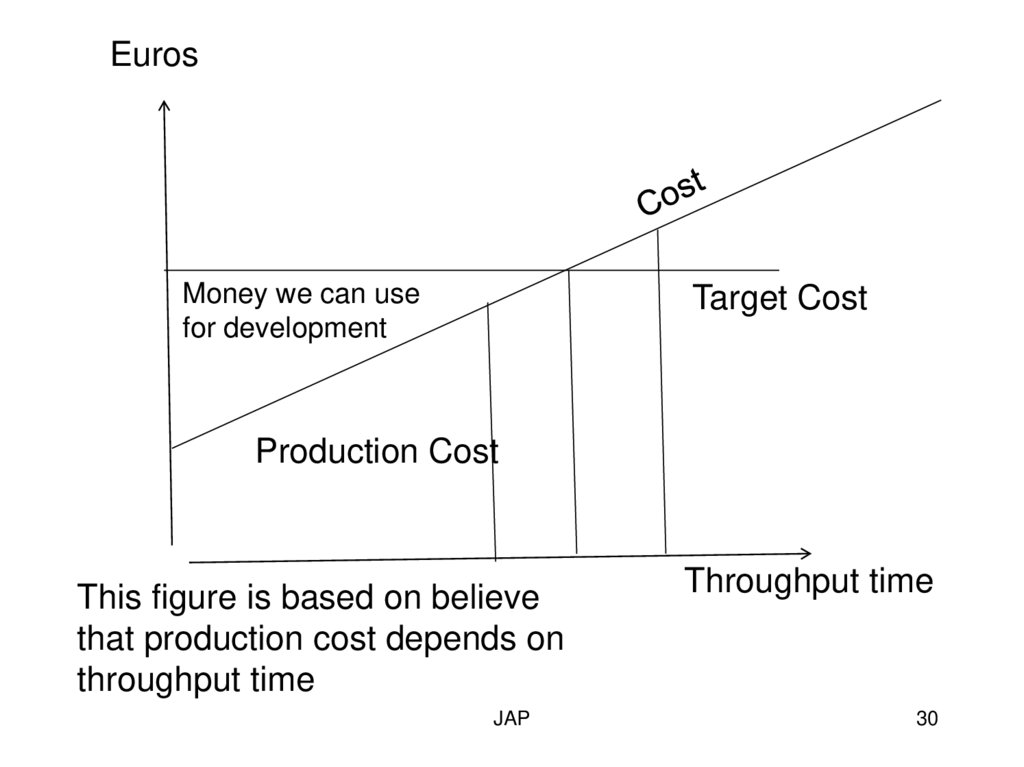

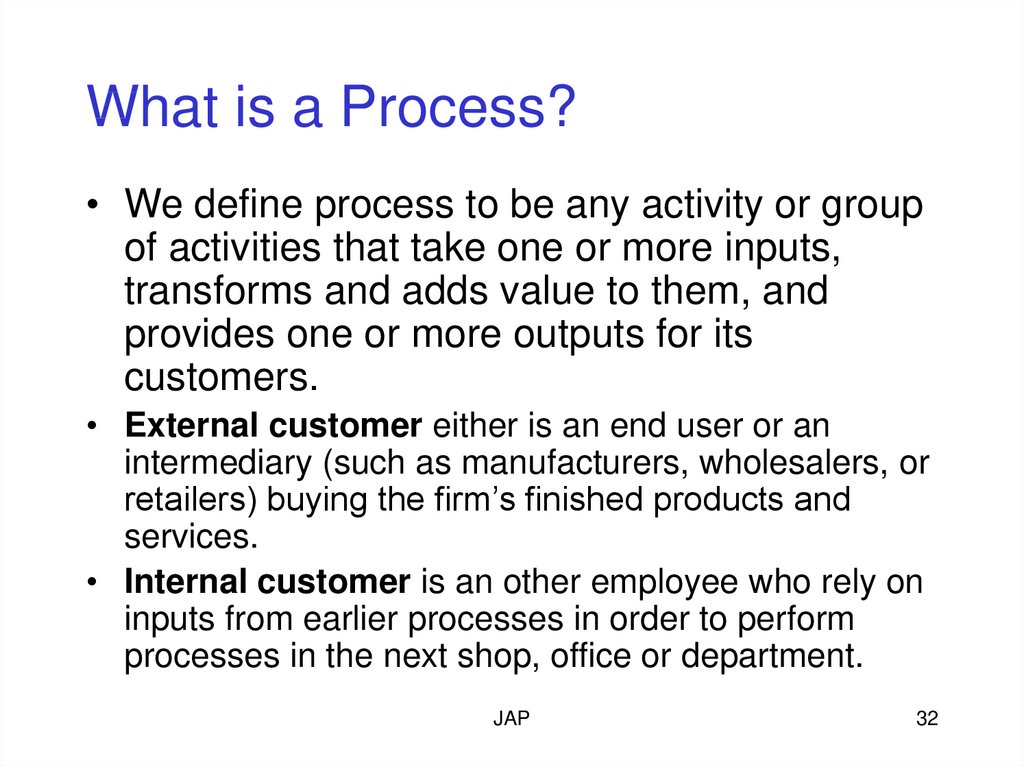









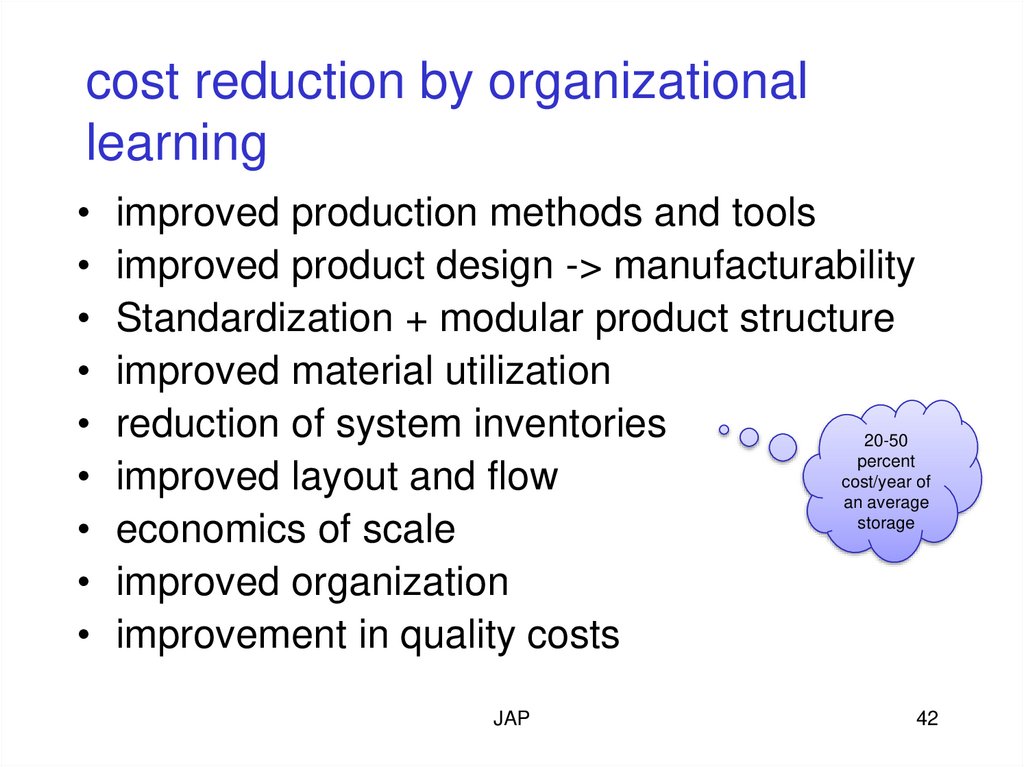



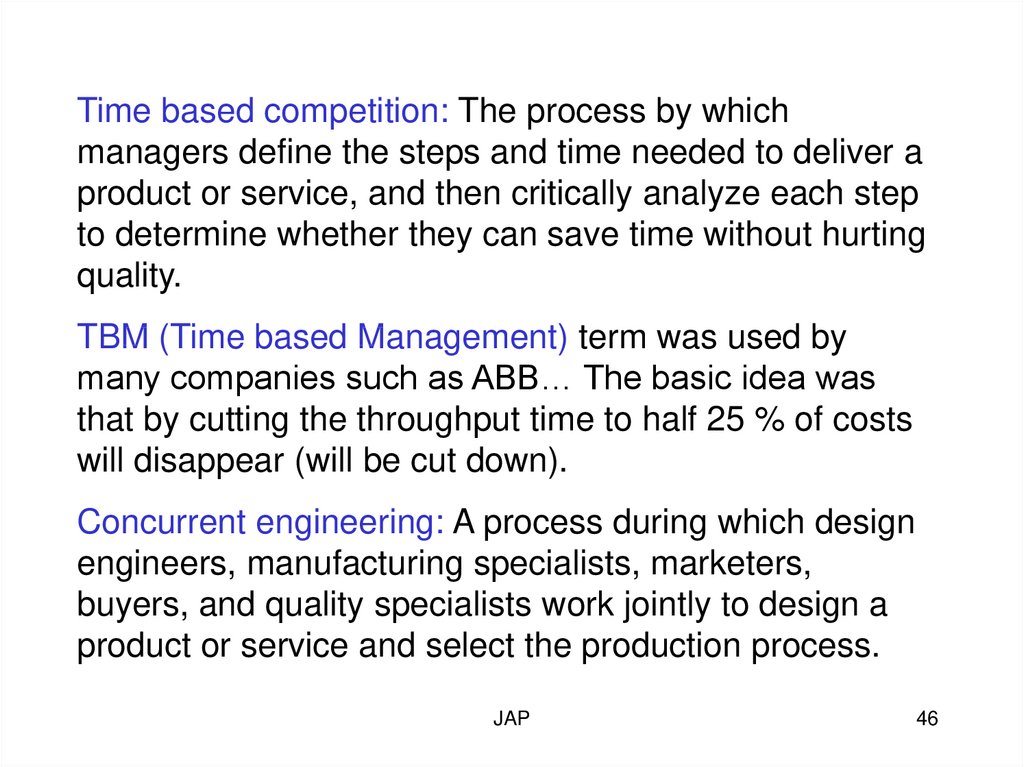



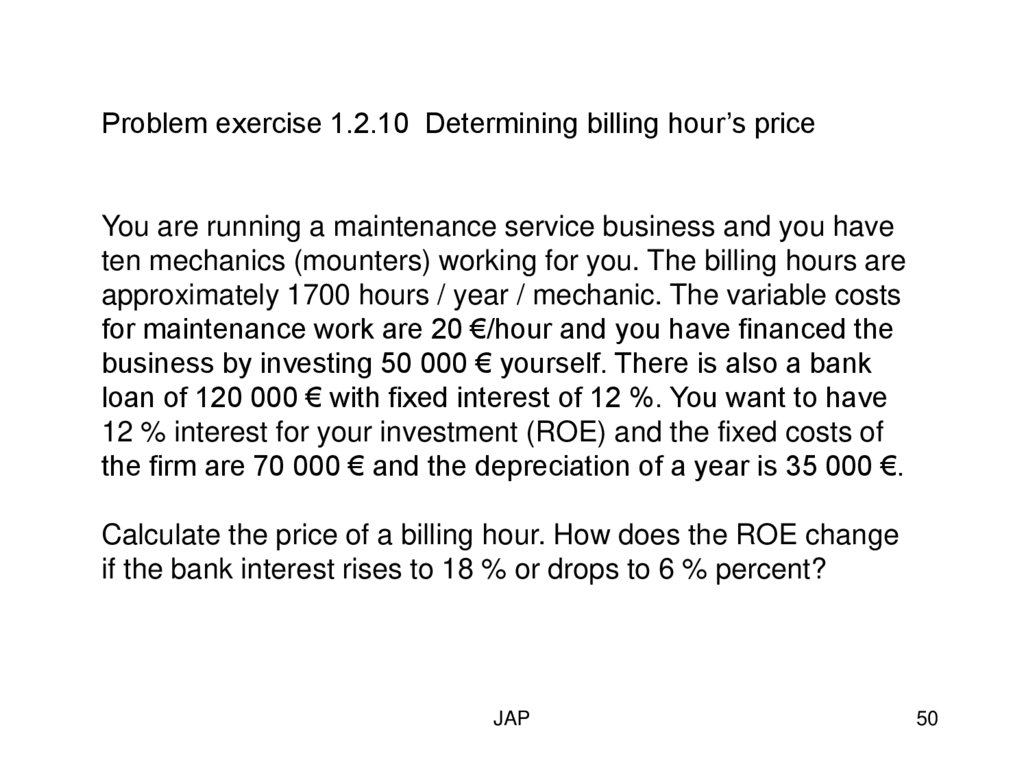
 management
management








